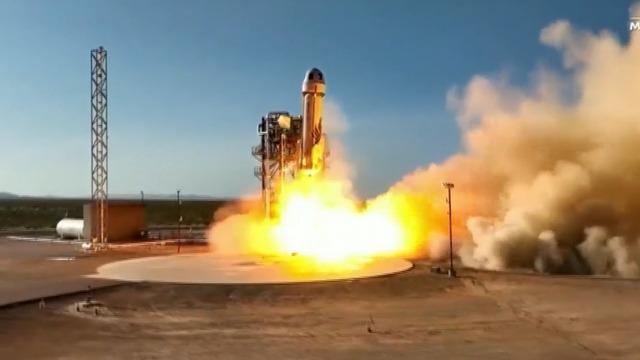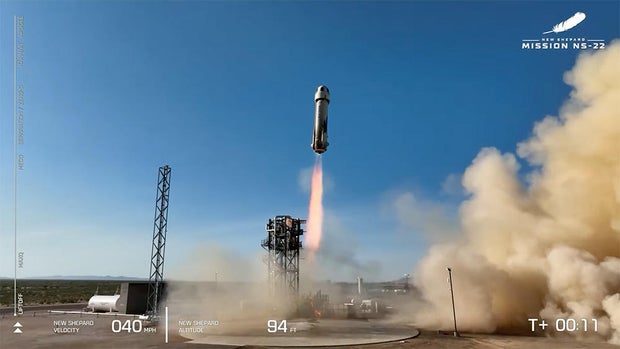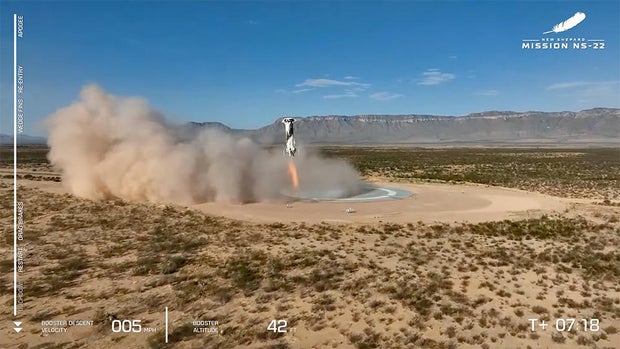▶ Watch Video: Explorer makes history on busy day of spaceflight
Jeff Bezos’ Blue Origin launched its sixth New Shepard passenger flight Thursday, taking a half dozen space tourists on a supersonic dash to the edge of space and back, complete with a few minutes of weightlessness and out-of-this world views from 66 miles above west Texas.
As the spacecraft coasted up to the high point of its trajectory, a microphone in the crew cabin captured cries of elation and wonder as the passengers unstrapped, began floating about and marveling at the spectacle of Earth far below and the deep black of space above.
“We’re doing it!” one shouted. “Oh my God!” gasped another. “Look at the blackness,” someone exclaimed. One crew member offered a bit of advice: “take it in, take it in!”
The flight began when the New Shepard’s single-stage rocket roared to life and the rocket blasted off from Blue Origin’s Van Horn, Texas, flight facility at 9:57 a.m. EDT, shooting straight up into a clear blue sky atop a brilliant jet of flaming exhaust.
On board: a British-American mountain climber, an Egyptian space enthusiast, a Portuguese investor and adventurer, a telecom executive-turned restauranteur, an engineer and a co-founder of the YouTube channel “Dude Perfect.”
The hydrogen-burning BE-3 first-stage engine boosted the New Shepard crew capsule to a velocity of 2,239 mph and an eventual altitude of 351,232 feet, well above the U.S. and international standards used to define the “boundary” between the discernible atmosphere and space.
The capsule then arced over and fell back to Earth. Moments after the spacecraft’s three main parachutes unfurled and inflated, a crew member loudly joked: “We’re not going to die!” Also: “Our poor families!”
Mission duration, from launch to landing: 10 minutes and 20 seconds.
For Sara Sabry, a 29-year-old Egyptian mechanical and biomedical engineer who lives in Berlin while studying for a Ph.D. in aerospace sciences, the length of the flight was not as important as what it symbolized.
“When we dare to dream big, we achieve things deemed impossible, we break boundaries, write history and set new challenges for the future,” she told Space for Humanity, the organization sponsoring her flight.
“I am incredibly excited that Space For Humanity has offered me this opportunity and I am honored to be representing Egypt in space for the first time. My ancestors have always dreamt big and achieved the impossible, and I hope to bring that back. This is just the beginning.”
Also on board: Coby Cotton, one of five co-founders of “Dude Perfect,” one of the internet’s most heavily subscribed sports channels; Mario Ferreira, a Portuguese investor; mountain climber Vanessa O’Brien; Clint Kelly III, an engineer with expertise in autonomous driving systems; and Steve Young, former CEO of a large telecommunications company and now a restaurant developer in Melbourne, Florida.
“With the sale of the company came lots of stupid money,” Young told the Florida Today newspaper. “And with stupid money, you can do stupid things. … I have always been a bit of a braggart-slash-showoff. And what’s better than to be able to say you went to space when your buddies can’t?”
Blue Origin does not discuss how much it charges for a flight aboard the New Shepard. But Quartz reported MoonDAO, a “decentralized autonomous organization” built on the ethereum blockchain, paid $2,575,000 for two New Shepard seats, including Cotton’s. The second seat has not yet been assigned.
“Thanks to the transparency of the blockchain, we know it cost MoonDAO $2,575,000,” Quartz reported. “Some of that is transaction fees, but the figure suggests that a seat on New Shepard costs $1.25 million.”
The NS-22 mission marked the 12th piloted commercial, non-government sub-orbital spaceflight and the sixth for Blue Origin, which is the early leader in a high-stakes competition between Jeff Bezos and Richard Branson, the billionaire owner of Virgin Galactic.
Branson won the commercial sub-orbital space race in 2018 when his company launched its first piloted test flight above 50 miles, the boundary of space recognized by NASA and the FAA. Branson flew as a passenger on the company’s fourth flight in July 2021, its most recent, joining two pilots and three other Virgin Galactic employees.
Bezos, his brother Mark, aviation pioneer Wally Funk and Danish teenager Oliver Daeman took off on Blue Origin’s first piloted sub-orbital flight on July 20, 2021, nine days after Branson’s launch.
Virgin Galactic has not yet announced a date for its next flight, but Blue Origin followed up the Bezos flight by launching a suite of NASA experiments on an unpiloted mission the next month. Then, on October 13, 2021, William Shatner and three crewmates were launched on the company’s 18th flight overall and the second carrying passengers.
Three more crewed New Shepard flights followed on Dec. 11, 2021, March 31 this year and most recently on June 4.
Unlike Virgin’s VSS Unity spaceplane, which is launched from a carrier jet and glides to a runway landing after a brief visit to the lower edge of space, Blue Origin’s New Shepard is a much more traditional rocket and capsule.
In a little more than two minutes, the single-stage booster propels the capsule and its crew straight up to an altitude of about 32 miles and a velocity of some 2,200 mph before main engine shutdown.
A few seconds later, at an altitude of about 45 miles, the crew capsule is released to fly on its own.
While the reusable booster heads back to landing on a nearby pad, the crew capsule continues upward on an unpowered, ballistic trajectory, reaching a maximum altitude of just above 65 miles three-and-a-half minutes after takeoff.
The Fédération Aéronautique Internationale (FAI), an international body based in Switzerland that certifies aerospace records, considers an altitude of 100 kilometers, or 62 miles, as the dividing line between the discernible atmosphere and space.
NASA and the FAA say 50 miles is the point where wings and aerosurfaces no longer have any effect on a vehicle’s motion and thus defines the starting point of “space.” Virgin Galactic uses that guideline while Blue Origin meets both standards.
After release from the New Shepard rocket, passengers experience about three minutes of weightlessness, enough time to unstrap and float about the cabin while enjoying spectacular views of Earth through six windows more than a three feet tall and nearly two-and-a-half feet wide.
Plunging back into the lower atmosphere, the capsule rapidly decelerates, briefly subjecting the passengers to more than five times the normal force of gravity, before three large parachutes unfurl, lowering the craft to a gentle touchdown a few miles from the launch pad.
All of that appeared to go like clockwork Thursday.





































